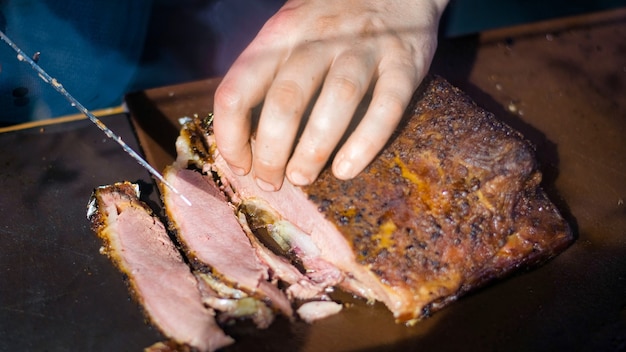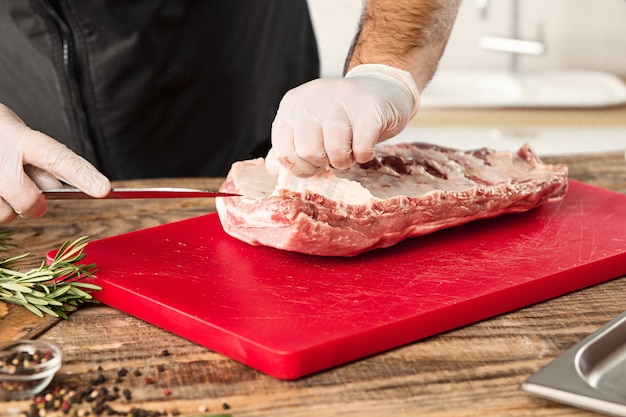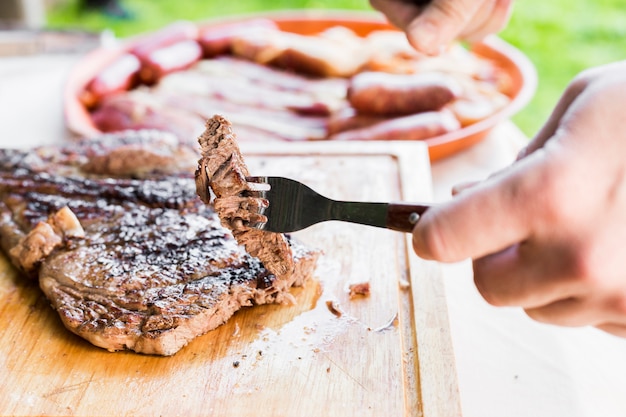There's something truly magical about a perfectly cooked sirloin steak. It's a dish that can elevate a simple weeknight dinner to a celebratory feast. As a seasoned home cook, I've spent years perfecting my sirloin steak game, and I'm thrilled to share my tried-and-true methods with you. This guide will walk you through every step, from selecting the perfect cut to achieving that mouthwatering sear. Get ready to impress yourself and your loved ones with the most delicious sirloin steak you've ever tasted!
(Part 1) The Foundation of Flavor: Choosing Your Sirloin

The foundation of any great steak is, of course, the meat itself. Choosing the right sirloin cut is crucial. I always opt for a sirloin steak that's at least 1 inch thick. This ensures a juicy and tender result. If you're feeling fancy, a bone-in sirloin steak adds an extra layer of flavor and a touch of rustic charm. Don't be afraid to ask your butcher for recommendations – they're experts! I remember one time, I was looking for a sirloin steak for a special occasion dinner. The butcher suggested a dry-aged sirloin steak, and it was a revelation! The intense flavour was unlike anything I'd tasted before. He explained how dry-aging develops a deeper, more concentrated flavour. That was the day I became a dry-aging convert!
Choosing the Right Grade: Understanding the Labels
You'll find different grades of sirloin steaks at the supermarket, each representing a different level of quality and marbling. While you can get away with a Select or Choice grade for a good steak, I personally prefer Prime. It's the highest grade and boasts more marbling, which translates to a juicier and more flavorful steak. The marbling, those little streaks of fat, helps to keep the meat moist and adds a fantastic richness to the flavour. If you're on a budget, a Choice grade steak will still be delicious.
Marbling: The Key to Juiciness
Here's a little secret: Marbling is your best friend. The more marbling, the more succulent your steak will be. It's the intramuscular fat that melts during cooking, keeping the meat moist and tender. When you're at the butcher counter, take a good look at the meat. Look for those beautiful streaks of fat, and don't be afraid to ask your butcher for a cut with good marbling.
(Part 2) Prepping for Perfection: Getting Your Steak Ready

Now that you've got your sirloin, let's get it ready for cooking. It's all about taking your time and ensuring your steak is at room temperature. Don't skip this step!
Bring It Up to Room Temperature: The Importance of Even Cooking
This is crucial for even cooking. A cold steak will cook unevenly, leaving you with a tough exterior and a cold center. To bring your steak to room temperature, simply remove it from the fridge about 30 minutes before you plan to cook it. Just make sure to leave it on a plate or cutting board. You wouldn't want it to pick up any unwanted flavours from your counter!
Pat it Dry: The Key to a Perfect Crust
Once your steak is at room temperature, pat it dry with paper towels. This step may seem minor, but it's essential for achieving a crispy sear. Moisture on the surface of the steak can create steam, preventing the steak from achieving that beautiful brown crust. A good sear is what gives your steak that irresistible flavour, so don't skip this step!
Seasoning: A Simple but Powerful Step
Now for the seasoning, and let's face it, good seasoning is what makes a simple steak truly spectacular. I like to keep things simple. Salt and pepper are your best friends, and you can't go wrong with a good quality kosher salt and freshly ground black pepper. I often add a pinch of garlic powder and onion powder for a little extra flavour. Just remember, a little goes a long way. Season your steak generously on both sides, but be mindful not to overdo it. Too much salt can make your steak tough.
(Part 3) The Art of Searing: Achieving a Perfect Crust

Searing is where the magic truly happens. It's the key to creating that irresistible crust and locking in the juices. This is what makes your sirloin steak truly sing.
Hot, Hot, Hot: The Importance of Temperature
A scorching hot pan is essential. cast iron skillets are ideal for searing because they retain heat beautifully. Aim for a temperature of around 450°F (232°C). You'll know your pan is hot enough when a drop of water sizzles immediately. I remember one time, I was trying to sear a steak in a pan that wasn't hot enough. The steak just steamed and stuck to the pan! It was a total disaster.
Oil, Oil, Oil: Choosing the Right Oil
Now, let's talk about oil. You want an oil with a high smoke point, like avocado oil or grapeseed oil. These oils can handle the high heat without burning or smoking. I often use a combination of olive oil and avocado oil. The olive oil adds a lovely flavour, and the avocado oil helps to keep the smoke point high. Another option is to use clarified butter. It has a high smoke point and adds a delicious buttery flavour to your steak.
Searing Perfection: The Technique
Add a generous amount of oil to the pan and let it heat up completely. Then, carefully place your steak in the pan. Resist the urge to move it around right away. Let it sear for 2-3 minutes on each side without touching it. The initial sear creates a beautiful crust and keeps all those delicious juices inside. After those initial minutes, you can use tongs to flip the steak to get a nice even sear on all sides.
Don't Forget the Sides: Adding More Flavor
While the steak is searing, don't forget about the sides. Take advantage of the hot pan and quickly sear any vegetables you might be serving. I like to throw in some sliced onions, mushrooms, and bell peppers for a flavorful medley. The veggies will soak up the delicious steak juices and add a delightful element to your meal.
(Part 4) Cooking to Perfection: Reaching Your Desired Doneness
Searing is just the beginning of the cooking journey. Now it's time to dial in the perfect level of doneness. Remember, everyone has their preference.
Understanding Doneness: A Guide to Temperatures and Textures
Here's a quick guide to help you understand the different levels of doneness:
| Doneness | internal temperature (°F) | Internal Temperature (°C) | Description |
|---|---|---|---|
| Rare | 125-130 | 52-54 | Red center, warm to the touch |
| Medium-Rare | 130-135 | 54-57 | Pink center, slightly firm |
| Medium | 135-140 | 57-60 | Slightly pink center, firm |
| Medium-Well | 140-145 | 60-63 | Very little pink, firm |
| Well-Done | 145-150 | 63-65 | No pink, firm and cooked through |
To check for doneness, I like to use a meat thermometer. It's the most reliable way to ensure your steak is cooked to your liking. If you don't have a thermometer, you can always use the finger test. Gently press the center of the steak. If it feels soft, it's rare. If it feels firm, it's medium. If it feels very firm, it's well-done. But remember, these are just rough estimates! A meat thermometer is your best bet.
(Part 5) Resting: A Crucial Step for Juiciness
After you've reached your desired doneness, it's time to let your steak rest. This may seem like an extra step, but it's essential for maximizing juiciness and tenderness.
Why Resting Matters: The Science Behind It
While your steak is cooking, the juices become concentrated in the center. When you cut into a hot steak, those juices flow out, leading to a drier, less flavorful cut. Resting allows the juices to redistribute evenly throughout the meat, resulting in a more tender and flavorful steak. It's a simple step that makes a big difference!
How to Rest Your Steak: A Simple Technique
Transfer your steak to a cutting board and loosely cover it with aluminum foil. Allow it to rest for at least 5-10 minutes. While you wait, you can prepare your sides and get your plates ready. It's a perfect time to make sure everything is in order!
(Part 6) Slicing and Serving: Finishing Touches
Now that your steak is rested, it's time for the final step: slicing and serving.
Slicing Technique: The Right Way to Cut
Slice your steak against the grain. This means slicing perpendicular to the muscle fibers. Cutting with the grain results in tougher, less tender meat. Slicing against the grain makes it easier to chew and creates a more tender texture. This is a simple tip, but it's a game-changer!
Serving Suggestions: Beyond the Basic
There are endless possibilities when it comes to serving your perfectly cooked sirloin steak. You can keep it simple with a classic side of mashed potatoes and steamed green beans, or get creative with roasted vegetables, a creamy mushroom sauce, or a vibrant salad. A simple sprinkle of fresh herbs, like rosemary or thyme, can add a touch of elegance to your presentation.
(Part 7) Tips and Tricks: Elevate Your Steak Game
I've learned a few tips and tricks over the years that have taken my sirloin steak from good to phenomenal. Here are a few of my favourites to try!
reverse searing: A Gentle Approach
For a more evenly cooked steak, try reverse searing. This technique involves cooking the steak in a low oven before searing it in a hot pan. The steak cooks slowly and evenly, ensuring that the inside is perfectly cooked while maintaining the delicious sear. This method is particularly helpful for thicker cuts of steak as it ensures the center is cooked thoroughly without overcooking the outside.
Adding Flavor: Elevate the Taste
Experiment with different seasonings and marinades. A simple marinade of soy sauce, garlic, and ginger can elevate your steak's flavour profile. You can also try adding herbs like rosemary, thyme, or oregano for a fresh and aromatic twist.
Pan Sauce: A Final Touch of Magic
Don't forget the pan sauce! While your steak is resting, you can deglaze the pan with a little wine or broth, scraping up all those delicious caramelized bits. Add a touch of butter and herbs for a luscious sauce that will take your steak to the next level.
(Part 8) FAQs: Answering Your Steak Questions
You have questions? I have answers! Here are some common questions about sirloin steak and how to make it perfect:
1. What's the Best Way to Store My Steak?
Always store your steak in the coldest part of your refrigerator, wrapped tightly in plastic wrap or aluminum foil. This will help to keep the meat fresh and prevent freezer burn.
2. How Long Can I Store My Steak in the Fridge?
A sirloin steak can be safely stored in the fridge for 3-5 days. It's best to use it within that timeframe to ensure the best quality.
3. Can I Freeze My Steak?
Yes, you can freeze your sirloin steak. Wrap it tightly in plastic wrap or aluminum foil, then place it in a freezer-safe bag. It can be frozen for up to 3-4 months. Just make sure to thaw it in the refrigerator overnight before cooking.
4. How Do I Avoid Overcooked Steak?
Use a meat thermometer! This is the most accurate way to determine the internal temperature of your steak and avoid overcooking. Also, pay attention to the cooking times and watch your steak closely. You can always take it off the heat a few minutes early and let it rest to prevent overcooking.
5. What Happens if I Overcook My Steak?
An overcooked steak will be tough and dry. It will lose its juicy and flavorful texture. It's best to err on the side of undercooked rather than overcooked. A slightly pink center is a sign of a perfectly cooked steak.
There you have it! My guide to making the perfect sirloin steak. Now, go forth and conquer! And remember, cooking is an adventure, so don't be afraid to experiment and find your own personal steak-making style. Enjoy!
Everyone is watching

Prime Rib Roast Cooking Time Chart: Per Pound Guide
Cooking TipsPrime rib roast. Just the name conjures images of lavish dinners, crackling fires, and hearty laughter. It’s ...

How Long to Bake Potatoes in the Oven (Perfect Every Time)
Cooking TipsBaked potatoes are a staple in my kitchen. They're incredibly versatile, delicious, and surprisingly easy to m...

Perfect Rice Every Time: The Ultimate Guide to Cooking Rice
Cooking TipsAs a self-proclaimed foodie, I've always been a bit obsessed with rice. It's the foundation of countless cuisi...

The Ultimate Guide to Cooking Asparagus: Tips, Techniques, and Recipes
Cooking TipsAsparagus. The mere mention of this spring delicacy conjures up images of vibrant green spears, crisp and burs...

Ultimate Guide to Cooking the Perfect Thanksgiving Turkey
Cooking TipsThanksgiving. Just the word conjures up images of overflowing tables laden with delicious food, the scent of r...
